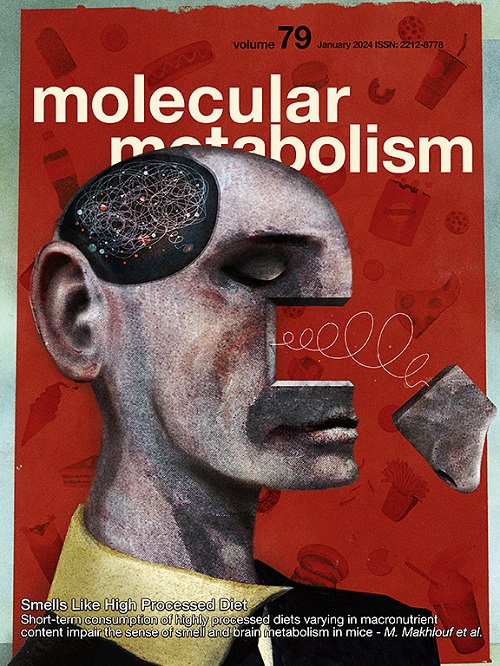14-3-3ζ allows for adipogenesis by modulating chromatin accessibility during the early stages of adipocyte differentiation
IF 7
2区 医学
Q1 ENDOCRINOLOGY & METABOLISM
引用次数: 0
Abstract
Objective
We previously established the scaffold protein 14-3-3ζ as a critical regulator of adipogenesis and adiposity, but whether 14-3-3ζ exerted its regulatory functions in mature adipocytes or in adipose progenitor cells (APCs) remained unclear.
Methods
To decipher which cell type accounted for 14-3-3ζ-regulated adiposity, adipocyte- (Adipoq14-3-3ζKO) and APC-specific (Pdgfra14-3-3ζKO) 14-3-3ζ knockout mice were generated. To further understand how 14-3-3ζ regulates adipogenesis, Tandem Affinity Purification (TAP)-tagged 14-3-3ζ-expressing 3T3-L1 preadipocytes (TAP-3T3-L1) were generated with CRISPR-Cas9, and affinity proteomics was used to examine how the nuclear 14-3-3ζ interactome changes during the initial stages of adipogenesis. ATAC-seq was used to determine how 14-3-3ζ depletion modulates chromatin accessibility during differentiation.
Results
We show a pivotal role for 14-3-3ζ in APC differentiation, whereby male and female Pdgfra14-3-3ζKO mice displayed impaired or potentiated weight gain, respectively, as well as fat mass. Proteomics revealed that regulators of chromatin remodeling, like DNA methyltransferase 1 (DNMT1) and histone deacetylase 1 (HDAC1), were significantly enriched in the nuclear 14-3-3ζ interactome and their activities were impacted upon 14-3-3ζ depletion. Enhancing DNMT activity with S-Adenosyl methionine rescued the differentiation of 14-3-3ζ-depleted 3T3-L1 cells. ATAC-seq revealed that 14-3-3ζ depletion impacted the accessibility of up to 1,244 chromatin regions corresponding in part to adipogenic genes, promoters, and enhancers during the initial stages of adipogenesis. Finally, 14-3-3ζ-regulated chromatin accessibility correlated with the expression of key adipogenic genes.
Conclusion
Our study establishes 14-3-3ζ as a crucial epigenetic regulator of adipogenesis and highlights the usefulness of deciphering the nuclear 14-3-3ζ interactome to identify novel pro-adipogenic factors and pathways.
14-3-3ζ允许在脂肪细胞分化的早期阶段通过调节染色质可及性的脂肪形成
我们之前已经确定支架蛋白14-3-3ζ是脂肪形成和肥胖的关键调节因子,但14-3-3ζ是否在成熟脂肪细胞或脂肪祖细胞(APCs)中发挥其调节功能尚不清楚。方法制备脂肪细胞- (adipoq14 -3-3 - ζ ko)和apc特异性(pdgfra14 -3-3 - ζ ko)的14-3-3ζ敲除小鼠,以揭示14-3-3 - ζ调控的肥胖细胞类型。为了进一步了解14-3-3ζ如何调节脂肪形成,用CRISPR-Cas9生成了串联亲和纯化(TAP)标记的表达3T3-L1的14-3-3ζ前脂肪细胞(TAP-3T3-L1),并使用亲和蛋白质组学来检测核14-3-3ζ相互作用组在脂肪形成的初始阶段如何变化。ATAC-seq用于确定14-3-3ζ损耗如何调节分化过程中的染色质可及性。我们发现14-3-3ζ在APC分化中起关键作用,因此雄性和雌性Pdgfra14-3-3ζKO小鼠分别表现出体重增加受损或增强,以及脂肪量。蛋白质组学显示染色质重塑的调节因子,如DNA甲基转移酶1 (DNMT1)和组蛋白去乙酰化酶1 (HDAC1),在细胞核14-3-3ζ相互作用组中显著富集,其活性受到14-3-3ζ缺失的影响。用s -腺苷蛋氨酸增强DNMT活性可以挽救14-3-3 - ζ缺失的3T3-L1细胞的分化。ATAC-seq显示,14-3-3ζ缺失影响了多达1,244个染色质区域的可及性,这些区域在脂肪形成的初始阶段部分对应于脂肪形成基因、启动子和增强子。最后,14-3-3 - ζ调控的染色质可及性与关键脂肪生成基因的表达相关。我们的研究确立了14-3-3ζ是脂肪形成的关键表观遗传调控因子,并强调了破译核14-3-3ζ相互作用组对识别新的促脂肪因子和途径的有用性。
本文章由计算机程序翻译,如有差异,请以英文原文为准。
求助全文
约1分钟内获得全文
求助全文
来源期刊

Molecular Metabolism
ENDOCRINOLOGY & METABOLISM-
CiteScore
14.50
自引率
2.50%
发文量
219
审稿时长
43 days
期刊介绍:
Molecular Metabolism is a leading journal dedicated to sharing groundbreaking discoveries in the field of energy homeostasis and the underlying factors of metabolic disorders. These disorders include obesity, diabetes, cardiovascular disease, and cancer. Our journal focuses on publishing research driven by hypotheses and conducted to the highest standards, aiming to provide a mechanistic understanding of energy homeostasis-related behavior, physiology, and dysfunction.
We promote interdisciplinary science, covering a broad range of approaches from molecules to humans throughout the lifespan. Our goal is to contribute to transformative research in metabolism, which has the potential to revolutionize the field. By enabling progress in the prognosis, prevention, and ultimately the cure of metabolic disorders and their long-term complications, our journal seeks to better the future of health and well-being.
 求助内容:
求助内容: 应助结果提醒方式:
应助结果提醒方式:


